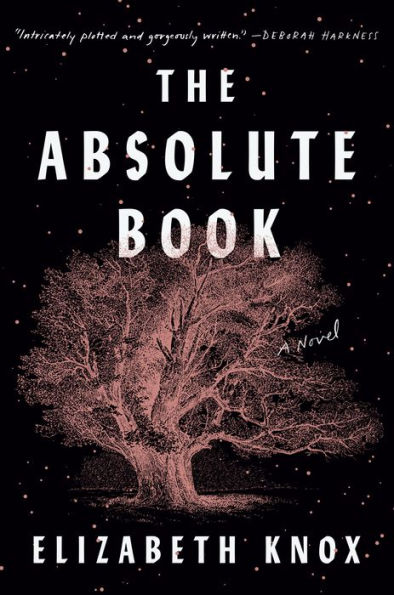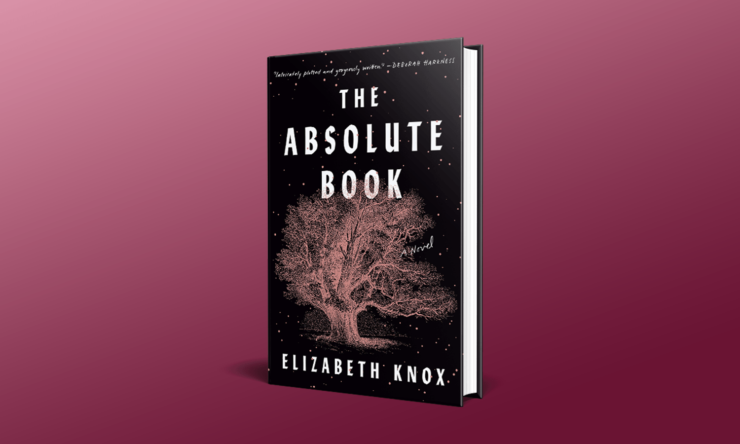Elizabeth Knox’s The Absolute Book begins with a description of the novel in Beatrice Cornick’s bag on the day she was murdered: a conspiracy thriller of the Da Vinci Code variety, treasured because Beatrice loved to read stories set in museums and libraries. The presence of such a book is a talisman—it describes the genre and action of The Absolute Book itself and, more vitally, gestures to the role of libraries in our cultural imagination. Places of wonder and hidden treasures that can change the world, libraries, museums, and archives are fraught, politicized, and dangerous things. Taryn Cornick, Beatrice’s sister and the novel’s protagonist, knows this better than anyone.
The Absolute Book has been heralded for its genre-defying depths, its twists and turns and satisfying lack of explanations. But what about the other books it contains? What about the volumes upon volumes of history and knowledge that lie hidden between its lines? When it’s not describing battles between demons and fae, or hired assassins, the police, and MI5, this 600-page tome has quite a lot to say about the archive. Whether it says quite enough in those 600 pages is another question.
The plot of The Absolute Book is difficult to describe, spanning from assassination plots to portal fantasy to allegory. Matt Keeley does a solid job of it in his review, though it’s worth noting that the novel becomes convoluted at times. Sussing out what it’s “about” is a tricky thing. Most immediately, though, The Absolute Book is about the destruction of books. It’s quite literally built into the novel’s structure, with each part titled with something that damages books: Insects, Fire, Light, Damp, Carelessness, and Uncaring. Taryn’s book, The Feverish Library, which she spends the story publishing and promoting, is inspired by the fire in her grandfather’s library growing up. She is fascinated with the preservation of texts and the forces that have destroyed them throughout history. In spite of this, Taryn becomes frustrated with the continual return in interviews and Q&As to the question of Nazis and censorship. Malevolent destruction alone is not the problem. By supposing that it is, we spectacularize and distract from something that is more often quiet, persistent, and even passive: what knowledge is not deemed worthy of preservation and accessibility, what is forgotten in the shuffle of the present, what becomes so lost we aren’t even aware that it’s gone.
Buy the Book


The Absolute Book
The character on which so many of these ideas hinge is Shift: half-Sidh, ever-changing, and impossible to clearly see, Shift seems to connect every nexus of a constantly-evolving plot (and world). Taryn may be the novel’s protagonist, but it is unambiguously Shift’s story. And not only is he a character that takes delight in the written word of humans, but his arc also partly hinges on a curse that embodies the vitality of storytelling. The curse erases Shift’s memory every couple hundred of years, forcing him to rely on the words of others to know who he is and what he’s done. Words, history, and story are so clearly vital to our sense of self—individual, collective, or otherwise.
Shift is also, notably, not white. The novel doesn’t shy away from mentioning Shift’s racial ambiguity, either—it may even do so in excess. His brownness is clearly meant to add to his aura of mystery, in-betweenness, and suspiciousness, with people trying to “figure him out” while not really knowing what it is they’re seeing. Shift is “other” because he’s not human—but he is also other because he’s not white.
So what does Shift’s race—and the question of race in the novel in general—mean to The Absolute Book’s ideas regarding libraries and archives? Race and the historical archive is well-trod territory for scholars of color. Saidiya Hartman approaches the problem of chattel slavery specifically: how few stories—let alone first-hand accounts—remain about enslaved women. Instead, these women are recorded as and reduced to numbers. “The stories that exist,” she writes, “are not about them, but rather about the violence, excess, mendacity, and reason that seized hold of their lives, transformed them into commodities and corpses, and identified them with names tossed-off as insults and crass jokes.”
The archive is, in this case, a death sentence, a tomb, a display of the violated body, an inventory of property, a medical treatise on gonorrhea, a few lines about a whore’s life, an asterisk in the grand narrative of history.
–Saidiya Hartman “Venus in Two Acts”
The spell that Shift’s mother placed on him as a child makes him quite literally unseeable and hidden. We might read his race as an aspect of that hiddenness—his struggle to find his place in the world is obscured by the world’s inability to see him. He is unwritten and illegible. “Being hidden has been difficult for me,” he admits in one of the novel’s final scenes.
The racial violence that bubbles beneath the story doesn’t stop there. The Sidh at large—and Shift in particular—often “Take” humans that have been deemed by society to be unimportant, rescuing them from lives of pain and obscurity. “The numberless others of history,” Taryn calls them, “marks in a ledger… we have value, but it has nothing to do with who we are.” The Sidh don’t aid these “numberless others” unproblematically, of course—they are sacrificed to Hell in the Tithe every two hundred years in order for the Sidh to remain immortal. In one harrowing scene, a group of humans, including some survivors of the middle passage, literally try to prove their worth to the Sidh so they won’t be chosen to be sacrificed. Add to this the subsequent revelations that the Sidh are breeding humans to be sacrificed and that they quite literally colonized the land they live on, displacing the demons that are now wreaking havoc in the human world—and the link between the Sidh and violent white supremacy and settler-colonialism become clear.
Shift’s drive to create change—to end the Tithe and use the Firestarter (an ancient, mysterious, and unburnable text) to reconnect the humans, Sidh, demons, and gods—inexorably links the novel’s concerns with the archive to race and even racial justice. Reclaiming memory and knowledge through language and the written word is pivotal to creating change. Shift’s story becomes not just about recalling his own past and solidifying his own identity, but about using those stories and knowledge to prevent more violence against all “numberless others.”
I write these words with a great deal of ambivalence, however. There is a certain strength in the novel not stating its ideas and comparisons outright, however the connections I’ve drawn here are tenuous and generous. If my own memory is correct, every main character apart from Shift is white. Each time the narrator calls attention to his race, it exoticizes and others him. A good-faith reading would posit that the book is problematizing the way people—including the POV characters—perceive his race (“Yes, I look Syrian,” he says dryly at one point, “It’s recently caused me a bit of bother.”). However, the persistent descriptions of his racial otherness cast white characters as people whose races don’t need to be spoken because they’re the norm, they are unproblematic and unremarkable. Arguably, by conflating his race with his non-human status, they reifies brownness as exotic and foreign.
Shift is also, with all his gaps in memory, a person, not a people (actually, he’s a character, but you catch my drift—can a single character stand in for a systematic problem, especially when the real-life problem is still passively present in the novel?). When the human survivors of the middle passage are described, they are unnamed—objects, even when their objectification is being criticized. The love Taryn and the other characters (and presumably every single reader) feel for Shift can’t make up for the fact that he is also often the object and rarely the subject of the story.
And finally, the novel ends with an abrupt shift in what Taryn and Shift want to do with the Firestarter. To reclaim this lost text is not to restore stories and self-knowledge to those that have been denied them, but instead to solve humanity’s environmental harms. By ending the Tithe and reconnecting humanity to other realms, they are free to use this secret and esoteric knowledge to, it seems, solve global climate change. The gods and the Sidh have judged humans collectively to have been poor stewards of the Earth—not industrial capitalism or mass genocide and colonization, but humans in general are the “problem” that is solved.
Not every story can do everything—not even one this long. The novel itself cracks a joke about such a criticism when Taryn tells a condescending audience member during a Q&A that “a book for the general reader on an esoteric subject has to argue for its own interestingness by being interesting,” rather than by containing every piece of relevant information. I’m not interested in criticizing a white fantasy author from New Zealand for not being Saidiya Hartman. But the strange conflicts between the novel’s themes and ideas are difficult to ignore. The Absolute Book is clever enough that we might grant that it simply tried to do too much, that it was clumsy in its execution. We might see its strange decision to focus on climate change as implicitly diminishing the importance of race, colonization, and power to our houses of knowledge and story. Perhaps, even, its criticism of the racist archive is unintentional, even circumstantial.
Taryn argues throughout the book that preserving archives is an act of preserving our humanity. “I think we should act as if we have souls,” she says,
…Immortal souls we might imperil by cruelty or bad faith or a serious lack of charity. And if imagining that books have souls helps us believe we do, then books absolutely have souls.
By ultimately focusing on preservation and destruction (a zero-sum game)—The Absolute Book forgets that the souls of the books themselves might be in peril. It elides the problem of books’ actual contents, making the problem of libraries and archives a matter of whether a book is kept and why, and leaving out the credence paid—implicit or explicit—to those that do stay. By making the story revolve around the Firestarter—a much-sought holy text— the novel returns its message to one of conspiracy, of seeking a great hidden idea, rather than seeking the people that the archive itself has disappeared. The “numberless others of history” are lost, not just because the texts about them are lost or hidden—but because of who wrote the texts and why.
I welcome the idea that books and history and knowledge can change the world. The Absolute Book’s hope and optimism in the face of our past sins are some of its best features. But it is Shift’s ownership of his story—not Taryn’s quest for preservation alone—that will ultimately create that change.
Em Nordling is a writer & PhD student in Atlanta, GA.










